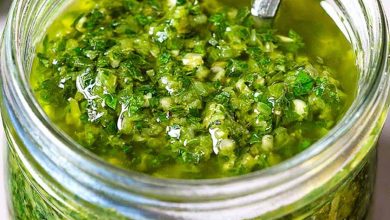Roti: The Perfect Unleavened Flatbread
Roti, a staple in many households around the world, is a simple yet essential dish that embodies the true essence of comfort food. Originating from the Indian subcontinent, roti is a type of unleavened flatbread that is easy to make, incredibly versatile, and pairs wonderfully with a wide array of curries, vegetables, and dips. Whether enjoyed at breakfast, lunch, or dinner, roti is a delightful addition to any meal.
Ingredients:
| Ingredient | Quantity |
|---|---|
| Whole-wheat flour (atta) | 500g |
| Water (approx.) | 300ml |
| Butter or oil | 1 tsp |
Allergen Information:
- Contains Wheat: This recipe includes whole wheat flour (atta), which contains gluten. This is important for individuals with celiac disease or gluten sensitivity to note.
- Dairy Option: The butter or oil used in this recipe is optional, allowing for dairy-free or vegan adjustments. You can substitute the butter with a plant-based oil or margarine to suit dietary preferences.
Dietary Preferences:
- Vegetarian: This roti recipe is entirely vegetarian, making it a great addition to plant-based diets.
- Vegan Option: For a fully vegan option, simply replace butter with any oil of your choice.
- Gluten Content: The recipe contains gluten due to the use of whole-wheat flour.
Preparation Instructions:
Step 1: Prepare the Dough
-
Begin by placing the whole-wheat flour (atta) into a large mixing bowl. Slowly add water, a little at a time, and use your hands to bring the flour together into a dough. The consistency of the dough should be soft, not too sticky. If the dough feels sticky, add a small amount of flour to help firm it up.
-
Once the dough comes together, begin kneading using your knuckles. Fold the dough over as you knead, ensuring it becomes smooth and elastic. Continue kneading until the dough no longer sticks to your hands or the sides of the bowl.
-
Once the dough is properly kneaded, cover it with a cloth or plastic wrap and set it aside for at least 30 minutes. This resting period allows the gluten to relax and makes the dough easier to work with.
Step 2: Rolling the Dough
-
After the dough has rested, prepare a flat surface with some dry flour (atta) for dusting. Take a small portion of dough, about the size of a tangerine, and roll it into a smooth ball using the palms of your hands.
-
Flatten the ball gently with your fingers, and then, with one hand holding the dough and the other hand rotating it, begin flattening the dough out evenly.
-
Flour the dough again, and with a rolling pin, gently roll it into a flat disc, turning the dough and re-flouring as needed to prevent sticking. Keep the thickness even, aiming for about 7cm in diameter.
-
Once the dough is rolled out, pick it up and pass it between your hands as if clapping. This action helps to even out the dough and shake off any excess flour.
Step 3: Cooking the Roti
-
Heat a tava (Indian griddle pan) or a non-stick frying pan over low heat. Once heated, place the roti flat onto the pan, ensuring that it does not fold over. It should sizzle slightly as it touches the hot surface.
-
After about 10 seconds, you will begin to notice the color of the roti darkening slightly. Flip the roti over using tongs or a spatula. Reduce the heat slightly if using a gas stove, as the roti can burn quickly.
-
As the roti continues to cook, small bubbles will appear on the surface. At this point, carefully pick up the roti using tongs and place it directly over the flame (if using gas). The roti should begin to puff up as hot steam fills it.
-
Allow the roti to puff up fully, turning it over to ensure it is evenly cooked. You can use a clean tea towel to gently press down on the roti, encouraging it to inflate with steam.
-
Once the roti has puffed up and is golden brown on both sides, remove it from the heat. Place it on a clean tea towel and cover it to keep warm.
Step 4: Serving the Roti
- Serve the warm, freshly made roti with your favorite curry, vegetable dishes, or dips. It pairs beautifully with lentils, yogurt, or even chutneys. The tender, soft texture of the roti makes it the perfect accompaniment to a variety of meals.
Tips for Perfect Roti:
- Flour Consistency: If you find that the dough is too sticky or too dry, adjust by adding small amounts of flour or water until the right consistency is reached. The dough should be soft but not wet.
- Resting Time: Allowing the dough to rest for at least 30 minutes helps achieve a smooth texture and makes the rolling process easier.
- Non-stick Pan: If you don’t have a traditional tava, a non-stick frying pan works just as well. Ensure it is heated well before placing the dough on it for even cooking.
- Alternative Cooking Methods: If you are not comfortable with cooking the roti directly on a flame, simply leave it in the pan, flipping it when necessary. Press down with a clean towel to help it puff up.
Nutritional Information (Per Serving – Serves 4):
| Nutrient | Value (approx.) |
|---|---|
| Calories | 150 kcal |
| Carbohydrates | 30g |
| Protein | 5g |
| Fat | 1g |
| Fiber | 4g |
| Sodium | 5mg |
Conclusion:
Roti is a timeless and beloved dish that is simple to make, versatile, and full of flavor. Whether you’re new to making roti or a seasoned pro, this recipe is sure to become a staple in your kitchen. With just a few basic ingredients and a little practice, you can enjoy fresh, soft roti every time. Pair it with your favorite curries, stews, or soups for a complete and satisfying meal. Its simplicity and deliciousness truly speak for themselves, making it a must-try for anyone interested in expanding their culinary horizons. Happy cooking!




